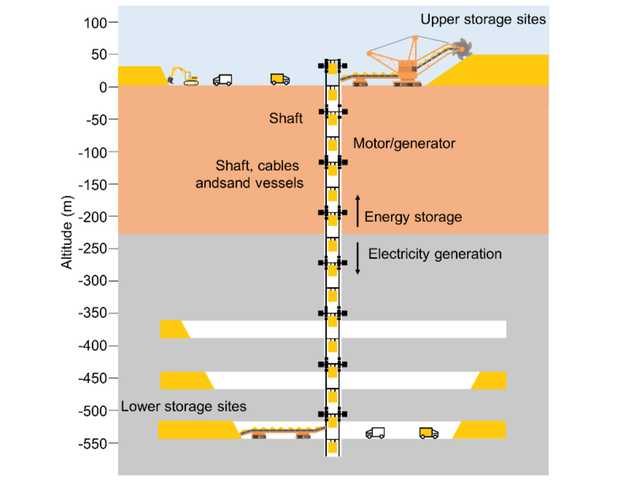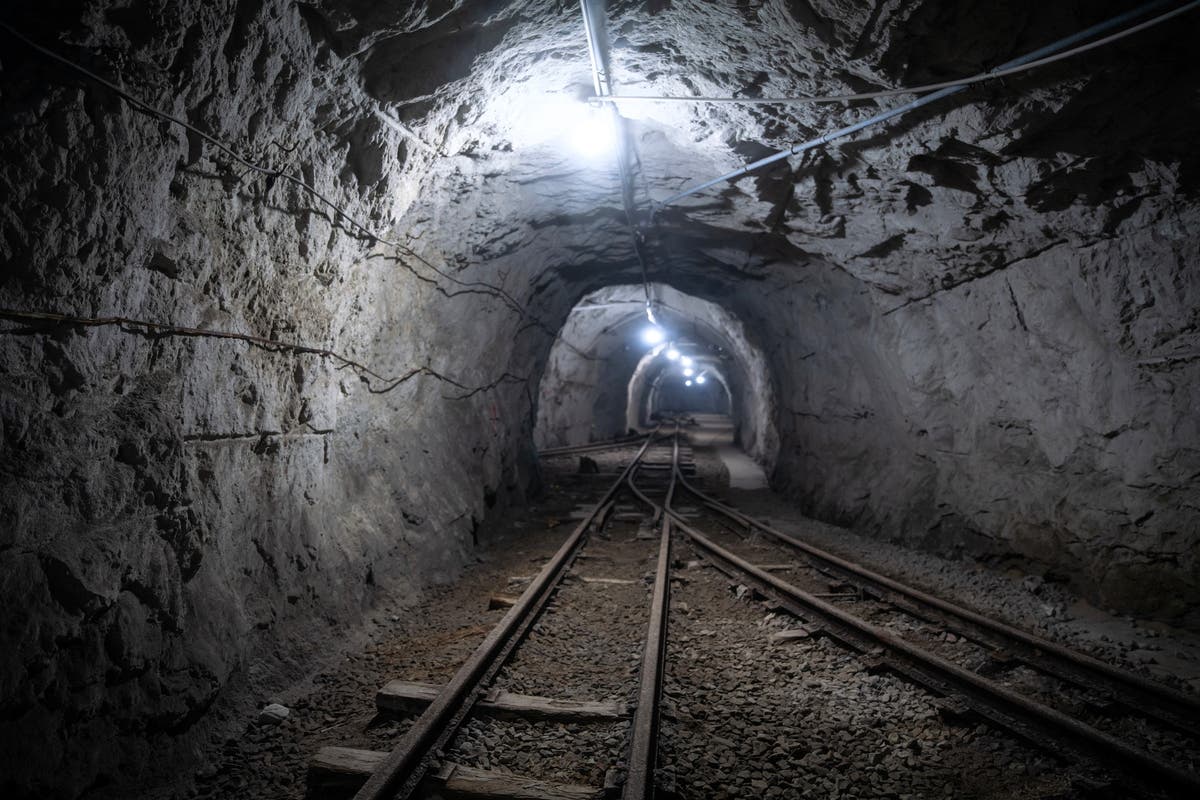An abandoned mine in Finland is set to be transformed into a giant battery to store renewable energy during periods of excess production.
The Pyhäsalmi Mine, roughly 450 kilometres north of Helsinki, is Europe’s deepest zinc and copper mine and holds the potential to store up to 2 MW of energy within its 1,400-metre-deep shafts.
The disused mine will be fitted with a gravity battery, which uses excess energy from renewable sources like solar and wind in order to lift a heavy weight. During periods of low production, the weight is released and used to power a turbine as it drops.
holds the potential to store up to 2 MW of energy
2nd paragraph and he’s already lost me. It would be nice if tech columnists had the equivalent of even a single semester of high school physics.
How many horsepower is your car’s gas tank?
Jiggawatts
I googled
Pyhäsalmi Mine gravitricity "2 MW"and EVERY article covering this has also cited 2 MW.Now, under Occam’s Razor, what’s more likely:
- Absolutely none of the article writers have any clue what the difference between a MW and a MWh is because none of them remember any physics
- Some of them could suspect that it’s wrong, but an authoritative source of the claim wrote/said 2 MW capacity when they meant “2 MW peak generation” or “2 MWh storage” (I’d presume Gravitricity, but I’m struggling to find such a source, myself)
- One writer miswrote/misquoted as per 2, and everyone is mindlessly recycling that original article’s contents with no attribution or care.
I don’t know which one it is. But I’d generally lean against 1.
#3 is a corollary of #1.
#2 is certainly food for thought. So the idea is that from a journalistic fact-checking point of view, it is more important to convey the information exactly as it was presented than to verify its accuracy?
This would explain why science/engineering-based articles are so commonly inaccurate or missing in critical details. The journalist can fall back on saying “I have a recording of an interview with the expert after we downed a few pints at the pub, and I’m just parroting back what he said. Don’t shoot the messenger!”
Just FYI, you need an escape backslant (\) preceeding the octothorpe (#) to not have your entire first paragraph bolded.
TIL that # is called an “octothorpe”. Thank you kind stranger.
It’s also correctly called:
- hash
- pound sign
- number sign
But cool people use the bespoke octothorpe.
The first appearance of “octothorp” in a US patent is in a 1973 filing. This patent also refers to the six-pointed asterisk (✻) used on telephone buttons as a “sextile”.
I’d honestly prefer raw parroting in most cases, even if it’s “obviously” wrong. I don’t want people selectively interpreting the facts as have been conveyed to them, unless they’re prepared to do a proper peer review.
That’s what [sic] is for though. You fact check, and then leave the quote as the press release had it.
The problem is that most of these articles are basically reprinting of the press release without any editorial additions at all.
I’d wager they let bots crawl articles and have said ai bots rewrite them slightly. Internet journalism is completely lost.
Mistakes like this could be avoided if we just used joules for energy and watts for power.
Or just joules per second for power. Eliminate watts entirely. Dumbass unit
Well, Watts are just a different way to write Joules per second. The unit we should eliminate is {k,M}W.h which introduce a 3.6 factor in conversions to/from the regular unit system
Yeah but if we all wrote “joules per second” instead of watts we’d encourage everyone to measure energy in joules instead of watt-hours. It’s like speed, we don’t need an entirely separate unit that just means m/s
It’s especially confusing when trying to size a surge protector. The surge protector uses joules, whereas most devices use watts, and you generally need more protection the more power your devices pull.
My fave has gotta be kwh/yr/ft². I came across that while researching the lighting requirements for hydroponics.
Well, it kind of makes sense to give a figure in such an unit. It allows you to quickly calculate how much you’re gonna spend on your electric bill (but only if you’re based in the US), since all weird conversions are already done
These cursed time units remind me of the super messy imperial units. Unfortunately, the French revolution wasn’t able to fix that, but it did fix a whole lot of other nonsense.
What’s even worse is that some units differ between the US and UK, such as a cup. So you can’t even assume the wacky units are even consistent within themselves, you need to know which country you’re talking about.
You know, there’s a reason why NASA and the US military use metric units. You just can’t afford to screw these things up because the units are a bit wonky.
Alright, I’ve been to high school but never understood “Wh”. For speed we say “They are moving at
25 km/haka 25km per hour” --> in one hour the object will have traveled 25km. per indicates division. Same for flow rate (cubic meters per second --> l/s) --> “The swimming pool of 5m³ was filled at0.5m³/hand took 10h to fill”.If something generates or consumes 10W per hour, shouldn’t that be 10W/h not 10Wh? If I hold an object that weighs 100g for an hour, doesn’t that mean I have been exerting myself at the gravitational force of the 100g object for 1 hour -->
(100g * 9.832m²/s) / h-->(100g*9.832m²/s) / 3600sand thus the units beingg * m² * s⁻²which are joules? How does that equate to “watt hours” Can somebody explain this to me conceptually? It makes no sense to me.What you’re forgetting is that Watt isn’t a unit of energy, it’s a unit of power, that is energy per time. So you wouldn’t say something generates 1W per hour, you’d just say something generates 1W. And if you multiply that by a unit of time, you get total energy. So an engine producing 2MW running for 5h would produce 10MWh, or 36GJ.
2MW is a measure of power, not energy.
Time for something to free fall 1.4km is about 17s, so the minimum capacity is 34MJ or 9.4kWh in order to make their statements true. $1.50 in electricity.
The weight doesn’t have to “free fall” for this to work. It could be a huge boulder that’s lifted a few centimeters per hour. And then it can be dropped a few centimeters per hour when needed.
Run the numbers.
How heavy a boulder? 10,000kg?
Potential energy is mass x height, so 10,000kg x 1,400m which is 14MJ of energy. Sounds like a lot, right?
One Joule is a watt flowing for a second and 1,000 watts flowing for 3,600 seconds is 1kWh. 3,600,000 Joules or 3.6MJ. So our 10 ton rock up a 1.4km shaft only stores 4kWhs? 60¢ of electricity?
Everything is linear here, so even having a 100 ton rock will only get us to half a EV battery.
Edit: if you’re wondering where the other 90 cents went, this example won’t produce two megawatts. It would only produce about 700 kilowatts.
Thanks for doing the math and for expanding.
The way I see it is: if I gather all the electricity I use to power my appliances in a week and just for one home - my home (fridge, heat, washing machines, vacuum cleaner, lightbulbs, laptop), and use it to lift that rock, how high will that rock get?
Also, I wasn’t even picturing a rock that small (10,000 kgs in water can be stored half a bedroom of a midsized apartment. Let’s just assume that it would take about the same volume in “rock.”) I was picturing a rock that’s 10m by 10m by 100m tall. More like 10,000,000 kgs.
You missed a factor of ten from the gravitational field strength, but still not great. Their heat batteries work better when it comes to heating, but that is mostly limited to just that.
Oh yes, mgh not mh. You’re right
It will be similar to a big pulley.
The weight will pull the turbine, the turbine will require a torque to generate current. This torque will act as an upwards force against gravity. This force will slow the fall of the weight significantly. The turbine ‘consuming’ the torque allows the weight to fall.
The higher the power output the faster it will fall. This will be adjustable. No power out = stationery. A small amount of power out, the descent speed will be tiny. A faster fall a higher power output.
This won’t be designed to fall at full speed. It’ll be designed for a long slow descent. The theoretical power will likely be much higher. It will be limited by the turbine and wiring capacity that’s rated at 2MW.
If your calculations are correct it will be able to generate $1.50 a second. It will also consume power that is below market price/free/paid to consume when it ‘charges’. It also provides the utility of stabilising the electrical grid against renewables. Increasing the capability of the grid to support more cheap renewable energy, without the lead time of nuclear or the pollution of biofuel.
How something be turning a huge ass generator (most likely) AND be in free fall…
You put a rope on it. The rope goes around the generator shaft/alternator as it would be with a steam/wind turbine.
Then it’s not free-fall…
Ah good point.
So your issue is a matter of labelling rather than science.
I sincerely doubt this is accurate or why would they even bother.
All solid weight gravity batteries are a scam. The sound good enough to get grant money, but if you run the numbers, they are pitiful batteries.
To make it worth while you need literal lakes of water.
deleted by creator
Very interesting, and good to hear.
Though, I’m not sure why they would drive a turbine to drive a generator, instead of just driving the generator directly. Their illustration doesn’t show any turbines either.
The turbine is the part that turns potential energy into rotational energy. The generator turns that rotation into electricity.
But isn’t the definition of a turbine “a type of machine through which liquid or gas flows and turns a special wheel with blades in order to produce power” with the “power” (aka. rotational energy) going to a generator?
Where does the liquid or gas come from? Isn’t this battery supposed to lift heavy, solid objects?
It doesn’t outright state that it uses solid weights, but their illustration looks more like they’d use a lift with sand or weights, and not a turbine with liquid or steam:

Just guessing here but I think they are playing with gear ratios. A large turbine with high resistance being slowly turned by a heavy weight could generate power for an extended period of time.
EDIT: Maybe the shaft is the turbine. Like a big rotating corkscrew.
And that’s my confusion, why use a turbine (connected to a lift) to turn the heavy weight into a flow of steam or liquid, presumably to convert this flow to electricity using another turbine with a generator connected to it, instead of simply converting the heavy weight to electricity using a lift (or corkscrew) to turn the generator?
This is, of course, assuming that a turbine only is a turbine when it is driven by steam or liquid.
I guess the publishers of the article either got the definition wrong, or there’s a less used definition of turbine which I am not aware of.
I been promoting this shit for a while now. Energy storage can be surprisingly low tech, it just needs to be built
2MW of energy 🤦♂️
Just walked the distance of 1.8 km/h.
I just waited for 2 light-years at the doctor’s office.
I did the kessel run in under 12 parsecs.
Isn’t this a little goofy? It presumes there will be extra electricity. Do you see any sign that we’ll be producing significantly more than we need? All i see is stupid decision after stupid decision. Can’t even build a nuclear reactor these days so barring a fusion breakthrough there are no big leaps to be made. That said, fusion does appear to be coming, but that’d also make this moot and hence silly.
On-demand (or surge) power generation like this is much different then base power generation like you get from solar, wind or nuclear (or theoretically fusion).
Long story short, any functional power grid needs both because generation has to match demand, and demand is uneven and wonky.
The most common surge power source is small natural gas plants. This is a replacement for those.
It presumes there will be extra electricity.
There’s always extra electricity. Eg. Solar generates power during the day, charges this “battery” and then powers lighting at night when demand is higher and people need to be able to see.
There’s always extra electricity. Eg. Solar generates power during the day, charges this “battery” and then powers lighting at night when demand is higher and people need to be able to see.
And this is only set to become more of an issue. Solar and wind are going to be a larger share of the energy mix, but they will still be unreliable. Energy storage, whether physical or chemical, will need to be part of the solution.











